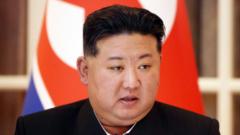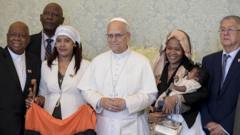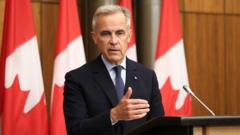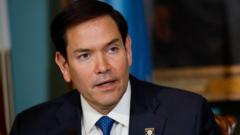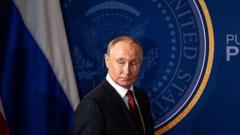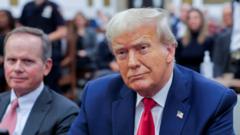President Trump has declared a 25% tariff on imports from South Korea and Japan, set to take effect on August 1. This move accompanies broader trade negotiations and aims at addressing perceived unfair trade practices.
Trump Plans to Introduce 25% Tariffs on Goods from Japan and South Korea
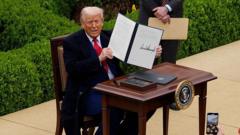
Trump Plans to Introduce 25% Tariffs on Goods from Japan and South Korea
The US president confirms impending tariffs as negotiations with other nations unfold amidst ongoing trade tensions.
Article Text:
President Donald Trump announced a significant change in trade policy, revealing plans to impose a 25% tariff on products imported from South Korea and Japan starting August 1. This announcement was made via social media, where Trump shared letters communicated to the leaders of both nations. The White House indicated that similar notifications will be sent to other countries as part of a renewed focus on tariffs following the end of a 90-day pause on the most severe import taxes.
These new tariffs reflect Trump's ongoing commitment to his trade agenda, which had initially outlined a 24% duty on Japanese imports and a 25% tax on South Korean goods back in April. This earlier announcement was part of a wider strategy labeled "Liberation Day," which included tariffs that escalated up to 40% on products from various countries. Following considerable backlash and market volatility triggered by the initial tariffs, the administration retracted some of the most extreme rates to facilitate negotiations while retaining a 10% tax on numerous imports.
As the window for negotiations to sidestep these higher tariffs is set to close on July 9, Trump has decided to delay the implementation of these duties. Treasury Secretary Scott Bessent emphasized an increase in negotiation proposals, expressing optimism about the engagement from trading partners.
The rationale behind the tariffs has been framed by Trump as a reciprocal measure intended to combat international trade practices he perceives as skewed against American exports. Trump's focus on tariffs extends beyond these announcements, including significant duties on steel and automotive sectors, often justified under national security claims. These multifaceted policies present challenges in ongoing trade discussions, particularly with Japan and South Korea.
While the U.S. has successfully negotiated agreements with nations like the United Kingdom and Vietnam, affecting tariffs in those cases, unresolved issues persist. Meanwhile, the European Union is also seeking a path forward; reports show that discussions are focused on retaining a provisional 10% tariff on most imported goods, while also negotiating adjustments to Trump's existing tariffs on automobiles and steel. Recent communications between Trump and EU leaders, including President Ursula von der Leyen, signal active engagement in these negotiations.
In the backdrop of this situation, Trump has signaled that repercussions could escalate; he recently threatened Japan with tariffs ranging from 30% to 35% if a satisfactory agreement isn't reached by Wednesday, further adding a layer of urgency to ongoing trade talks.
President Donald Trump announced a significant change in trade policy, revealing plans to impose a 25% tariff on products imported from South Korea and Japan starting August 1. This announcement was made via social media, where Trump shared letters communicated to the leaders of both nations. The White House indicated that similar notifications will be sent to other countries as part of a renewed focus on tariffs following the end of a 90-day pause on the most severe import taxes.
These new tariffs reflect Trump's ongoing commitment to his trade agenda, which had initially outlined a 24% duty on Japanese imports and a 25% tax on South Korean goods back in April. This earlier announcement was part of a wider strategy labeled "Liberation Day," which included tariffs that escalated up to 40% on products from various countries. Following considerable backlash and market volatility triggered by the initial tariffs, the administration retracted some of the most extreme rates to facilitate negotiations while retaining a 10% tax on numerous imports.
As the window for negotiations to sidestep these higher tariffs is set to close on July 9, Trump has decided to delay the implementation of these duties. Treasury Secretary Scott Bessent emphasized an increase in negotiation proposals, expressing optimism about the engagement from trading partners.
The rationale behind the tariffs has been framed by Trump as a reciprocal measure intended to combat international trade practices he perceives as skewed against American exports. Trump's focus on tariffs extends beyond these announcements, including significant duties on steel and automotive sectors, often justified under national security claims. These multifaceted policies present challenges in ongoing trade discussions, particularly with Japan and South Korea.
While the U.S. has successfully negotiated agreements with nations like the United Kingdom and Vietnam, affecting tariffs in those cases, unresolved issues persist. Meanwhile, the European Union is also seeking a path forward; reports show that discussions are focused on retaining a provisional 10% tariff on most imported goods, while also negotiating adjustments to Trump's existing tariffs on automobiles and steel. Recent communications between Trump and EU leaders, including President Ursula von der Leyen, signal active engagement in these negotiations.
In the backdrop of this situation, Trump has signaled that repercussions could escalate; he recently threatened Japan with tariffs ranging from 30% to 35% if a satisfactory agreement isn't reached by Wednesday, further adding a layer of urgency to ongoing trade talks.

